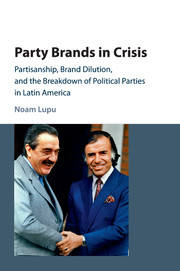 Party Brands in Crisis
Party Brands in Crisis Book contents
- Frontmatter
- Dedication
- Contents
- List of figures
- List of tables
- Acknowledgments
- 1 Why do parties break down?
- 2 Brand dilution and party breakdown
- 3 Explaining party breakdown across Latin America
- 4 Argentina: Peronism survives, Radicals collapse
- 5 Venezuela: AD and COPEI break down
- 6 Party brands and mass partisanship: experimental evidence
- 7 Party brands and mass partisanship in comparative perspective
- 8 Parties, partisanship, and democracy: conclusions
- Appendix
- Bibliography
- Index
Appendix
Published online by Cambridge University Press: 18 December 2015
- Frontmatter
- Dedication
- Contents
- List of figures
- List of tables
- Acknowledgments
- 1 Why do parties break down?
- 2 Brand dilution and party breakdown
- 3 Explaining party breakdown across Latin America
- 4 Argentina: Peronism survives, Radicals collapse
- 5 Venezuela: AD and COPEI break down
- 6 Party brands and mass partisanship: experimental evidence
- 7 Party brands and mass partisanship in comparative perspective
- 8 Parties, partisanship, and democracy: conclusions
- Appendix
- Bibliography
- Index
Summary
Formal model of partisanship and vote choice
Consider a multiparty democracy with M parties. Voters develop a perception of a party's brand over time on the basis of observations of party behavior. This brand is the perceived position of the party on the real line. For a voter who observes n actions by a party, denote her jth observation by yj, where j ∈ {1,...,n}. Voters observe some subset of the actions taken by parties in each electoral cycle – with some voters of course drawing more observations from this distribution than others – and use these observations to update their beliefs about party brands. I assume that each observation yj is a random draw from a distribution of observable party actions with unknown mean μ and unknown variance σ2. For simplicity, I assume a normal distribution of party actions, meaning that yj∼iid N(μ, σ2) for all j. Denote the sample mean of yj by ȳ.
During any particular electoral cycle, let k○ denote the number of observations on which a voter's prior beliefs about the party are based, such that at the end of each electoral cycle kn = k○ + n. Similarly, let v○ denote the degrees of freedom in the uncertainty of the voter's prior beliefs, such that vn = v○ + n.
For convenience, I assume that an individual's prior belief about the mean and variance of a party's position is represented by the normal-inverse-chisquared distribution, such that the posterior and prior distributions are drawn from the same family of distributions. As a result, prior beliefs about μ and σ2 are given by μ, σ2|y ∼ N − χ2(μn, kn, vn, σ2n), where k○, v○, σ2○ > ○. Decomposing the joint distribution of μ and σ2 into p(μ, σ2) = p(μ|σ2)p(σ2), we find that the true distribution of party actions given its variance (μ|σ2) is normally distributed with mean μ○ and variance. Here represents the voter's best guess about the position of the party at time ○ – that is, her prior – and represents the amount of uncertainty about that best guess. That uncertainty is based on the actual variance in the distribution of party actions (σ2) and the number of observations on which a voter's prior beliefs are based (k○).
- Type
- Chapter
- Information
- Party Brands in CrisisPartisanship, Brand Dilution, and the Breakdown of Political Parties in Latin America, pp. 185 - 204Publisher: Cambridge University PressPrint publication year: 2016
